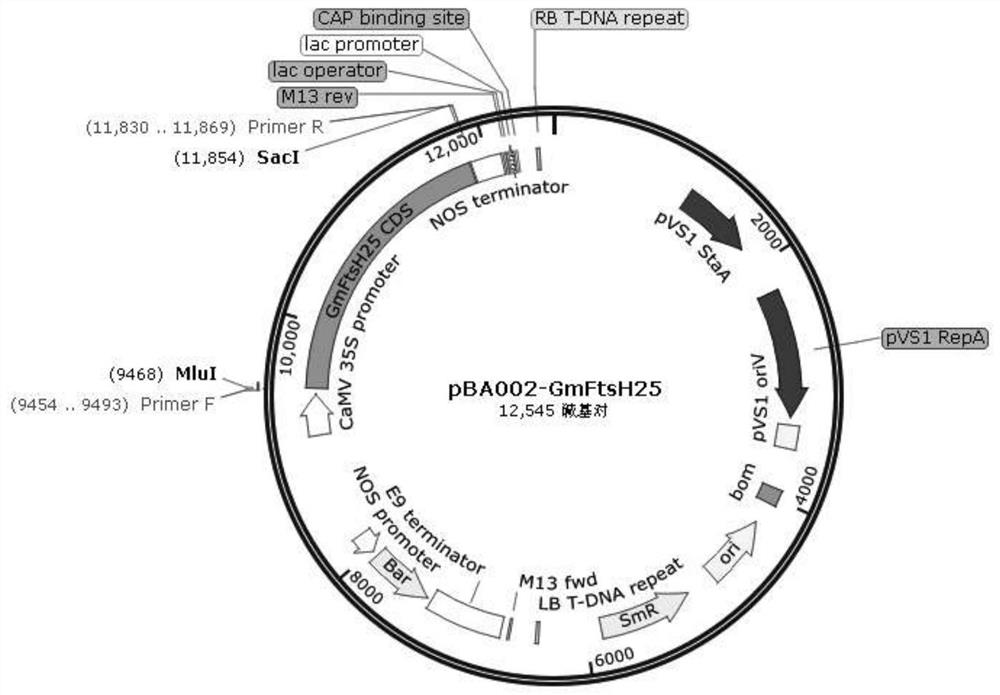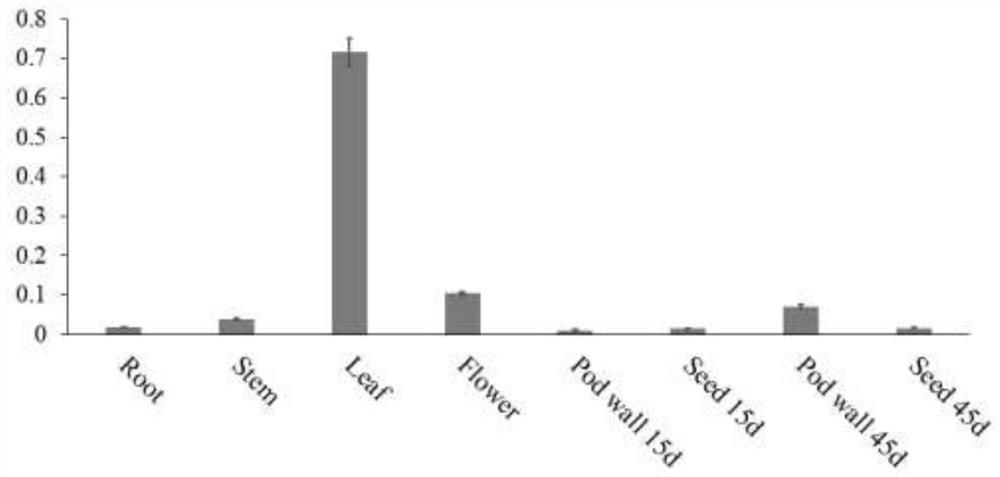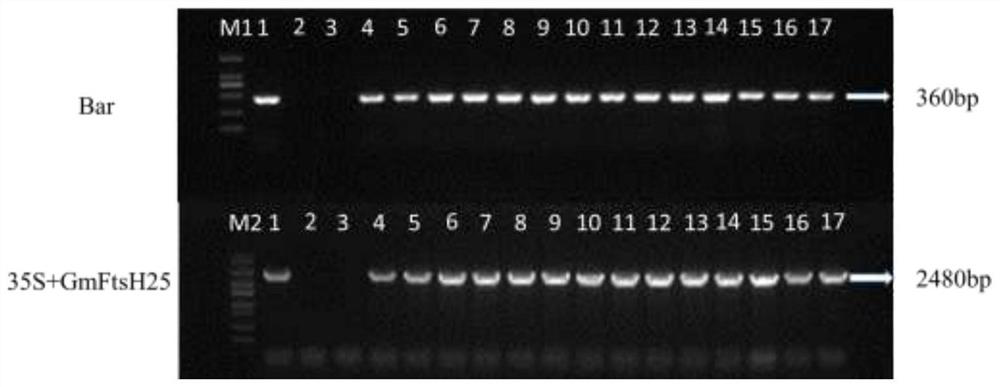Gene GmFtsH25 for encoding soybean FtsH metalloproteinase and application of gene GmFtsH25
A technology of metalloprotease and soybean, applied in the fields of application, genetic engineering, plant genetic improvement, etc.
- Summary
- Abstract
- Description
- Claims
- Application Information
AI Technical Summary
Problems solved by technology
Method used
Image
Examples
Embodiment 1
[0025] Embodiment 1, the tissue expression of soybean GmFtsH25 gene in Jack material
[0026] (1) Design primers, extract RNA, reverse cDNA:
[0027] The total RNA of each tissue of soybean Jack was extracted with a plant total RNA extraction kit (DP419, Tiangen), and the integrity of the RNA was detected by 1% agarose gel electrophoresis. cDNA synthesis reference Instructions for the 1st Strand cDNA SynthesisKit kit. Design primers as follows:
[0028] SEQ ID NO.3: GmFtsH25 qPCR primer F'5-CGACTGTGTTTGTGAGTGTGC-3'
[0029] SEQ ID NO.4: GmFtsH25 qPCR primer R'5-ACTCTGATTCCTGCAACCTACTAC-3'
[0030] SEQ ID NO.5: Tubulin qPCR primer F'5-GGAGTTCACAGAGGCAGAG-3'
[0031] SEQ ID NO.6: Tubulin qPCR primer R'5-CACTTACGCATCACATAGCA-3'
[0032] (2) Real-time fluorescent quantitative PCR, the specific steps are as follows:
[0033]Step 1: Dilute the cDNA samples of each tissue obtained in the above (1) 10 times for qPCR reaction, prepare the reaction solution (20 μl system) accord...
Embodiment 2
[0036] Embodiment 2, the cloning of soybean GmFtsH25 gene and the construction of plant overexpression vector
[0037] (1) Using the cDNA of soybean Jack leaves obtained in Example 1 as a template, the CDS fragment was amplified by high-fidelity polymerase chain reaction. Design primers as follows:
[0038] SEQ ID NO.7: Primer F'5- GGATCTTCCAGAGAT TACCCACGTTCCAAGTTCCG-3'
[0039] SEQ ID NO.8: Primer R'5- CTGCCGTTCGACGAT GCTTCGGAGCAATGGTGTCA-3'
[0040] (2) PCR amplification, the specific steps are as follows:
[0041] Step 1: Prepare PCR reaction solution (50 μl system) according to the following components: 25 μl 2×Planta MaxBuffer, 2 μl each of primers F and R, 1 μl dNTP Mix, 2 μl leaf cDNA template, 1 μl Super-Fidelity DNA Polymerase, 17 μl ddH 2 O make up the volume to 50 μl.
[0042] Step 2: The reaction was carried out on a BIO-RAD PTC-200 PCR instrument, and the reaction program was set as follows: pre-denaturation at 95°C for 3min; then 95°C for 15sec, 58°C f...
Embodiment 3
[0046] Embodiment 3, the cultivation of GmFtsH25 gene overexpression transgenic soybean
[0047] The pBA002-GmFtsH25 overexpression vector was transferred into the recipient material Jack by using the Agrobacterium tumefaciens-mediated transformation method of soybean cotyledonary nodes, and the specific method is described as follows:
[0048] (1) Select clean seeds that are mature and plump, without disease spots, and without hard solids, and arrange them in a single layer in a 90*15mm petri dish, and carry out dry chlorine gas sterilization on the surface of soybean seeds, and carry out in a fume hood for total sterilization Bacteria for 6-7 hours. Cover the petri dish and transfer it to a sterile ultra-clean bench, open the lid of the petri dish, and blow with strong wind for 25-40 minutes to remove residual chlorine gas. Sow the sterilized seeds on the germination medium (SG4) with the hilum facing down, stack the petri dishes, wrap them with plastic wrap, place them in ...
PUM
 Login to View More
Login to View More Abstract
Description
Claims
Application Information
 Login to View More
Login to View More - R&D
- Intellectual Property
- Life Sciences
- Materials
- Tech Scout
- Unparalleled Data Quality
- Higher Quality Content
- 60% Fewer Hallucinations
Browse by: Latest US Patents, China's latest patents, Technical Efficacy Thesaurus, Application Domain, Technology Topic, Popular Technical Reports.
© 2025 PatSnap. All rights reserved.Legal|Privacy policy|Modern Slavery Act Transparency Statement|Sitemap|About US| Contact US: help@patsnap.com



